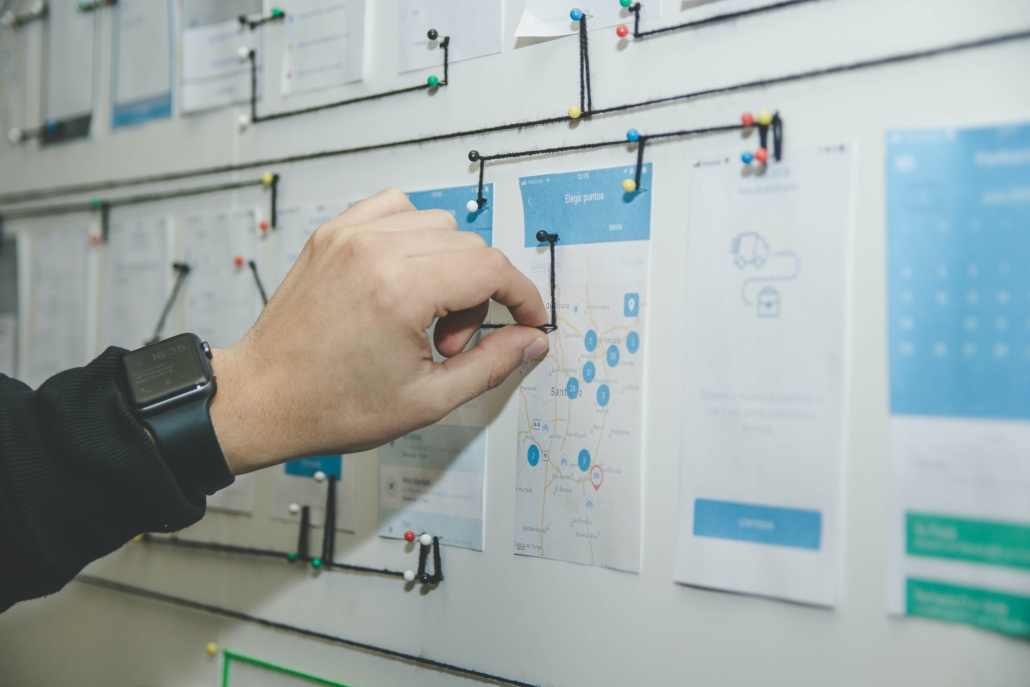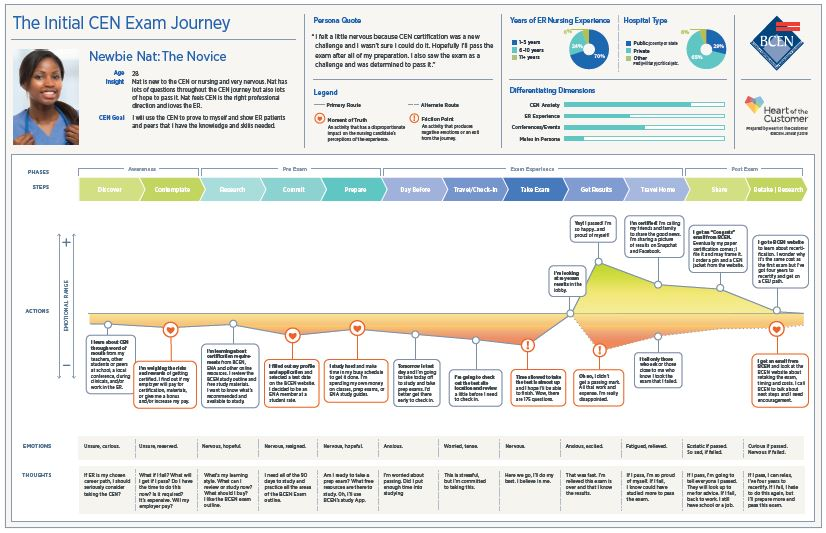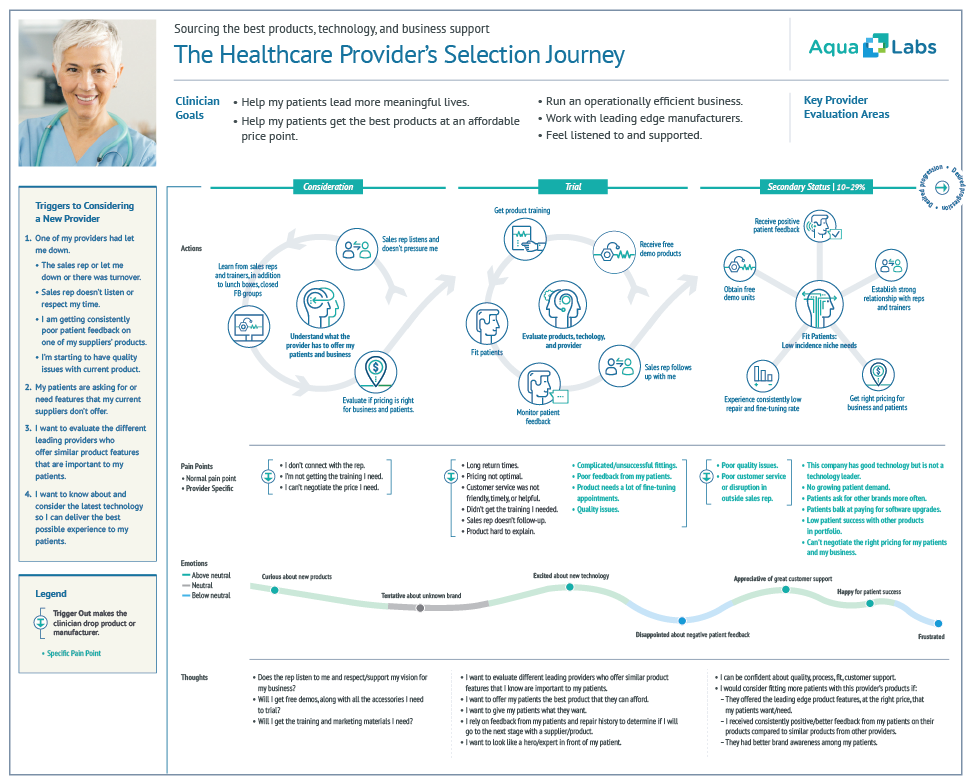

Gain a deep understanding of your customers’ experiences with your product or service as a CX professional. By doing so, you can identify areas for improvement and create a memorable customer experience. One effective method to achieve this is through customer journey maps.
Customer Journey Mapping is essential in capturing the complexity of your organization’s business model and interactions with all parties involved. It applies to B2C, B2B, and B2B2C environments.
In this blog post, we’ll provide you with real customer journey map examples to inspire and guide you in mapping your customers’ journeys.
A customer journey map is a tool used to understand the customer experience, identify patterns, and gaps in the customer journey. A customer journey map visually represents the path customers take across various touchpoints. It allows you to identify the current-state experience and optimize their journey. Journey maps vary in complexity, but the most effective maps paint a comprehensive picture of the customer’s experience, including their thoughts, feelings, and actions, at every touchpoint and interaction.

Customer journey maps are critical to creating a successful and sustainable customer experience strategy. Understanding the customer experience at each touchpoint can help businesses identify patterns of behavior, pain points that customers experience, and opportunities to improve the customer experience. By identifying these points, organizations can create targeted and effective strategies for improving customer satisfaction and retention.

Through extensive research, Heart of the Customer has developed the most effective customer journey mapping process that delivers results. Our process was born out of the insights gathered from the current state of journey mapping and customer success everywhere, as detailed in our book “How Hard Is It to Be Your Customer? Using Journey Mapping to Drive Customer-Focused Change.” This book, now in its second edition, highlights that two-thirds of journey mapping initiatives fail to drive customer-focused change, based on a global survey conducted by Heart of the Customer in partnership with the Customer Experience Professionals Association (CXPA).
Our four-phase process for customer journey mapping and improvement is as follows:

The discovery phase is the first step in our customer journey mapping process. In this phase, gather insights from various sources, including internal stakeholders, cross-functional teams, and customers.
Once your cross-functional action team is established, lead a working session and have the team document their hypothesized journey to create a customer journey map. The goal is to identify and prioritize customer pain points, critical moments in the customer journey, and opportunities for improvement. This workshop is crucial as it lays the foundation for the rest of the process, and drives excitement within the organization to hear from customers first-hand.

The second phase of our process involves engaging with customers to gain a deep understanding of their needs, expectations, and behaviors. We use a variety of qualitative and quantitative research methodologies, such as in-depth interviews, digital ethnographies, behavioral and operational data, and surveys to gather valuable insights.
This phase is essential to ensure a customer-centric approach to journey mapping and enables us to create a comprehensive view of the customer experience, from the customer’s perspective.

The action phase is where all of the critical insights are brought together through analysis and the customer journey map is realized. Our graphic designers create unique customer journey maps that highlight the critical Moments of Truth and present the greatest opportunities for improvement.
As a cross-functional Action Workshop, lead your cross-functional team through the current state journey map’s phases, touchpoints, and key themes. Build empathy by leveraging video clips from customer interviews to share the emotions, friction, and importance of each customer interaction.
In this workshop, work closely with cross-functional teams to brainstorm ideas, prioritize initiatives, and develop action plans. Develop a future-state journey map and identify the necessary steps to realize the vision that aligns with the organization’s goals and objectives, resulting in a seamless and personalized customer experience.

The final phase of our process involves implementing the future state journey and monitoring progress towards enhancing CX. We guide our clients through the launch phase by collaborating with teams to ensure that initiatives are executed effectively.
We establish metrics and KPIs to measure progress towards customer-focused change. This phase is critical as it enables organizations to continuously improve the customer journey and drive business results.

At Heart of the Customer, we help clients reimagine their customer experience through a data-driven approach to customer experience. Our customer journey mapping process provides organizations with the insights and tools necessary to enhance CX and drive long-term business success.
Our proven process can help businesses to identify and prioritize customer pain points, understand customer needs, and develop actionable plans to improve customer satisfaction. With our process, businesses can create a customer-focused culture that drives tangible business results.

B2C customer journey maps focus on the customer’s path in a business-to-consumer environment. It helps to identify the customer’s motivation, pain points, and emotions throughout their buying journey. The objective is to improve the product, service, or experience, acknowledging that customers have different motivations and needs.
Avery has been a reputable brand for over 75 years, known for their quality and durable products. While their school supplies line is available through online channels, including Amazon, as well as big-box and specialty stores, the company was facing challenges.
Technological advances, declining in-store sales, and competition from private-label brands were impacting their business. They recognized the need to engage with consumers more effectively.

To address these challenges, Avery embarked on a journey-mapping project. They aimed to gain a better understanding of how consumers make decisions about back-to-school supplies, taking into account factors such as children’s age, preferences for branded versus store products, and the most effective ways to communicate with parents.
By mapping the customer journey and identifying pain points and opportunities, Avery aimed to enhance the overall customer experience and build brand loyalty.
Customer journey mapping has become an essential tool for companies looking to improve customer experience and navigate the changing retail landscape. By uncovering consumer emotions and preferences throughout the shopping journey, organizations can develop effective strategies and stay ahead of the competition.
“Journey-mapping is a big up-front investment, but it’s necessary for long-term success. Being strategic and careful in how we allocate resources is crucial.” Melody Miyaji, Consumer Insights Manager at Avery
The journey-mapping project commenced in May, strategically timed for the back-to-school shopping season. Key stakeholders collaborated in a hypothesis mapping workshop to refine ideas and establish the most effective methodology for engaging parents throughout the journey, which extended until the start of the school year in September.
Avery was thrilled with the results of this effort, utilizing a workshop-generated framework to mine customer data and validate assumptions through surveys. By combining digital ethnography and targeted surveys, they gained comprehensive insights into the customer’s voice.

Data was collected through various channels, including forums, polls, diary studies, and surveys, involving more than 350 participants. This longitudinal approach allowed Avery to track changes in parents’ mindsets, attitudes, and motivations over time.
The shift in parents’ priorities and emotions throughout the journey was particularly enlightening. Initial focus on brand preference shifted to convenience as the school year progressed. Miyaji highlights the unique opportunity journey mapping provides in capturing these shifts and understanding the customer’s purchasing experience over time.
The process of identifying personas took a different route, as subjects were grouped based on the age of their children. This distinction was crucial for determining whether buying decisions varied based on the grade level, especially considering the increased autonomy of high school students.
Ultimately, journey maps were created for three distinct personas: parents of elementary-aged children, middle schoolers, and high schoolers.

The mapping process provided insightful findings that confirmed the team’s expectations. It highlighted the importance of involving consumers in journey mapping and revealed that initial internal assumptions can sometimes mislead businesses, causing them to prioritize perceived issues over actual opportunities.
The first significant discovery was that the back-to-school shopping journey didn’t start naturally in June, but rather when schools released their supply lists in early to mid-July. These grade-specific lists were the main driver for parents in all segments, shedding light on their importance.
The second key finding showed that despite the challenges and costs associated with back-to-school shopping, parents in younger age groups valued the bonding experience it provided. They enjoyed spending quality time with their children, making a day of it by having lunch or ice cream, allowing their kids to choose a special item, and engaging in shared activities.
Overall, the research confirmed that traditional retail still holds significance in the back-to-school shopping experience. It also suggested that this emotional connection likely extends to other aspects of the buying process too.
Fortunately, the study revealed no significant differences between consumer segments, providing reassurance to the team.

We completed the research and mapping and moved into the third phase of our journey-mapping protocol. During this phase, we led the cross-functional Avery team through an action planning workshop. The goal of the workshop was to develop both short- and long-term programs based on the insights we gathered from the journey maps.
In the workshop, the teams generated numerous ideas and categorized them into two types. They then voted on which ideas should move forward and receive further development. “Strategic ideas” focused on long-term direction, while “quick wins” aimed to provide immediate gratification and boost enthusiasm and engagement within the team.
Our customer journey mapping process – discovery, customer immersion, action, and launch – allowed Avery to focus its efforts on realizing the greatest return on its investment for multiple business outcomes and ensures that the voice of Avery’s consumers will be embedded in decision-making going forward.

Having a core team was critical to the success of the project. The core Avery team included Miyaji, Senior Product Manager Sheila Vega and the project sponsor Marketing Director Laura Cruz. A broader cross-functional team, spanning multiple departments, was also involved every step of the way.
“There was a time commitment, but it was spread over months,” Miyaji says, “including just making sure people were aware of the project and kept it top-of-mind and getting leadership on board supporting the research. When it came time for the action planning workshop, the hypothesis mapping workshop was still fresh in people’s minds even though it had taken place months before.”
The positive outcome of our journey-mapping experience has inspired Avery to apply this approach to all of our business categories. It has also instilled confidence in other business units to drive customer-focused action, who now express interest in adopting the methodology as the standard practice.

Customer Journey Mapping particularly important in B2B environments, which are, by nature, complex. Typically, the one buying your products is the buyer persona not the one using them on a day-to-day basis. And unlike a B2C shopper considering buying, say, a blender on Amazon, the purchasing decision might involve a months long decision-making process, dozens (if not hundreds) of stakeholders, committing to lengthy contracts, and investing millions of dollars.
A prominent B2B SaaS provider approached Heart of the Customer to map their implementation experience. Recognizing this as a crucial journey that significantly impacts growth and retention, our expertise was called upon.
Although this organization had a strong commitment to their customers, they lacked a formal customer experience (CX) program and the leadership team set a strategic initiative to formalize and mature a CX program, starting with understanding the customer journey map.

We engaged a cross-functional team and conducted in-depth interviews with their customer’s decision-making leaders, operational managers, and system integrator partners to understand the complete journey from the customer’s perspective. Like all of our engagements, we had the SaaS employees observe interviews with us, hearing the customer’s experience first-hand.
One key theme discovered from customer journey mapping was that the start of the journey – sales and contract negotiation – was positive. Once the handoff to their implementation partners happened, miscommunications started, promised deadlines slipped, and key features didn’t work as planned. Key players within their organization had to swoop in and solve big problems, leading to positive resolutions for the customer, but exposed numerous quick-wins for this organization to streamline and avoid the friction.

Without the customer’s perspective of the experience, the business assumed this wasn’t as impactful and wasn’t a priority. As a result of the customer journey mapping exercise, department leads came together with a comprehensive and unified understanding of priorities and spearheaded several key initiatives to improve the customer journey.
We assisted in creating a comprehensive job description based on industry standards and conducted interviews to identify a candidate who not only embraced the principles of the CX Loyalty Flywheel, but also focused on achieving meaningful business outcomes rather than just improving survey results.
Collaborating with the C-Suite, we embarked on an endeavor to establish a culture that prioritizes the customer. We developed a Culture Code and identified the necessary leadership behaviors to ensure that customers remain at the core of the organization’s operations.
Previously, the organization had a fragmented approach to CX measurement, with surveys being sent sporadically from different departments. Working alongside the newly appointed CX leader, we centralized the feedback process by incorporating both relationship and transactional surveys into a unified system with a shared dashboard.
Over time, disparate systems had been introduced within each department, resulting in a fragmented landscape where customers had to remember multiple passwords to access resources. We collaborated to devise a roadmap for centralizing capabilities and implementing a streamlined single sign-on process.
We are currently providing guidance on how to successfully introduce their new customer community, employing change management best practices to ensure that customers are equipped with the necessary tools and support for a thriving community experience.
Through our journey mapping, we identified six key emotions, such as Confidence, Exhaustion, Excitement, and Embarrassment, that heavily influenced customer behavior such as issue escalation and repurchase.
By integrating these emotions into their Journey Health Score, we discovered that they were the strongest predictors of repurchase likelihood. Actively monitoring this Emotional North Star and its impact on actual repurchase rates and cost-to-serve metrics is a critical success indicator for their improvement initiatives and proving CX ROI.
With undertaking these initiatives, our partnership with this B2B SaaS provider has led to remarkable improvements in net revenue retention, cost-to-serve, and customer satisfaction.

Discover how client journey mapping can revolutionize your enterprise by establishing strong connections with your customers. By tracking touchpoints from initial engagement to post-purchase, you can understand your clients’ needs, habits, and goals on a deeper level. This mapping process is particularly beneficial for businesses that sell to a business who, in turn, sells to end consumers.

Take a look at our customer journey map for a global insurance and asset management business. We focused on their independent financial professionals, whom they referred to as “Producers.” Our goal was to uncover the touchpoints, pain points, and Moments of Truth that significantly impacted the customer journey. With these insights, we aimed to develop strategies for retaining and expanding these critical B2B relationships.
But it wasn’t just about assumptions and hypotheses. We engaged directly with financial advisors to truly understand their perspective with 1:1 interviews. To our surprise, they expressed admiration for our client, stating that they wished every company could be as easy to work with.

Our analysis of these interviews led us to discover that these financial professionals were highly consultative and relationship-focused, actively contributing to their communities. Their main focus was helping their clients succeed, rather than personal purchases.
These findings prompted a shift in our client’s language, changing “Producers” to “Financial Professionals” or “FinPros.” This shift had a profound impact on the entire organization, influencing their marketing strategy and optimizing the customer journey to boost wallet share and retention with their FinPros. They now prioritize equipping their FinPros with the necessary tools, resources, and insights to better serve their clients.
Discover the proven strategies for successful journey mapping and improvement of customer journeys with Heart of the Customer’s comprehensive guidebook, “How Hard Is It to Be Your Customer? Using Journey Mapping to Drive Customer-Focused Change.” We were inspired to write this book by the realization that many organizations conduct journey mapping without achieving tangible results. Here, we outline the critical components that will help you enhance your customer journey.

According to Paul Batalden, Senior Fellow at the Institute for Healthcare Improvement, “Every system is perfectly designed to get the results it gets.” This explains why so many journey mapping initiatives fail to drive change. Our revolutionary approach is specifically designed to produce transformative outcomes. By incorporating the ADKAR change model and John Kotter’s 8-Step Change Process into our journey mapping approach, we ensure that content and processes work harmoniously to support effective change management.

Extensive research has shown that involving a broad cross-functional team is the most crucial factor in achieving successful journey mapping. By including representatives from various departments within your organization, we ensure that buy-in is obtained from all relevant teams. Our process entails three primary teams: the Day-to-Day Team responsible for project logistics, the Action Team creating the Hypothesis Map and generating solutions, and the Sponsor Team leading the organizational change. Refer to our Roles document (Appendix A) for further details on each team’s responsibilities.

To instill a sense of urgency and build a guiding coalition, it is vital to incorporate leadership into the journey mapping process. Our approach aligns with John Kotter’s framework, and regular meetings with the Sponsor Team ensure that leaders are kept up-to-date with key findings and their implications. This alignment is critical for driving change once the journey mapping is complete.

Utilizing Key Performance Indicators (KPIs) is standard practice for most organizations. We take this a step further by incorporating KPIs into our mapping process.
Through a journey health score dashboard, we visualize how operational, financial, sentiment, and behavioral metrics impact and relate to the current customer journey. Our methodology ensures that KPIs are used effectively, avoiding unintended negative consequences that may harm the customer experience.

Visual tools play a crucial role in engaging both leadership and staff. As John Medina noted in his book “Brain Rules,” visual input is more likely to be recognized and recalled. When creating your journey map, you have the flexibility to choose between software tools, an Excel spreadsheet, or a custom-made visual by a designer. All options have their advantages, but if the intended business outcome is to drive customer-focused change, we recommend eliciting graphic designer expertise in lieu of the use of generic templates.
Our customer journey maps are visually enticing, customized to your organization, and packed with easily digestible information. We discourage the use of generic templates. Our graphic designers start with a blank canvas and incorporate your brand guidelines to create a unique and compelling map that tells the story of your customers and highlights critical Moments of Truth that present the greatest opportunities for improvement.

To foster empathy and enable frontline staff to deliver exceptional solutions, we recommend leveraging customer video clips. This best practice allows you to capture key quotes and emotions, bringing the customer’s experiences to life. Our recording and editing processes with reduct.video ensure that you have powerful visual materials that truly resonate.

Journey mapping initiatives often fail to drive change because they lack a comprehensive change management approach. By incorporating change models like ADKAR and John Kotter’s 8-Step Change Process, organizations can ensure that their journey mapping efforts result in transformative outcomes. Involve diverse cross-functional teams and senior leadership to create your coalition for change, and your buy-in for investments in CX initiatives.
Incorporating KPIs into the journey mapping process enhances its effectiveness. By visualizing operational, financial, sentiment, and behavioral metrics through a journey health score dashboard, organizations can understand how these metrics impact the customer journey and avoid negative consequences that harm the customer experience.
Leveraging customer video clips helps foster empathy and enables frontline staff to deliver exceptional solutions. Capturing key quotes and emotions through well-edited videos brings the customer’s experiences to life, enhancing the impact of journey mapping efforts.
Having a deep understanding of your customer’s journey is essential for any business looking to deliver exceptional customer experiences. By using customer journey maps, you can gain insights into the touchpoints where your customers experience positive or negative emotions. This information is critical as it enables you to identify areas that require improvement and optimization.
Implementing learnings from the customer journey mapping examples provided above will help you master the art of mapping your customer’s journey, leading to unparalleled customer experiences that drive loyalty. By taking charge of your customer journey, you can create solutions that are tailored to your customer’s needs, leading to a memorable experience that keeps them coming back for more.
If you want to succeed in enhancing your customer experience, then Heart of the Customer’s expert CX consultancy will get you to meet your business objectives. We can help you drive meaningful change by providing actionable insights that enable you to optimize your customer journey and deliver a customer experience that exceeds expectations. At Heart of the Customer, we provide expert guidance to help you make impactful changes and measurable business impact.

